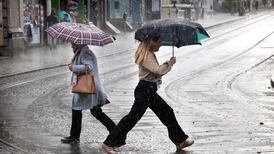THUNDERSTORMS occur when there is extreme unstable atmosphere, as has been the case in recent days, according to Gerry Scully, a forecaster with Met Éireann. Such conditions can eventually lead to the build-up of a charge, which can then be discharged as lightning in two ways: either within a cloud or by descending as a lightning bolt towards Earth.
Anyone who is caught outside during a lightning storm should stay away from the highest point as lightning is attracted to such points. Therefore, taking shelter under a tree can be the worst course of action.
Meanwhile, if you are indoors during lightning, the key is to stay away from any electrical cables, including television aerials and phone sockets, Mr Scully said.
"If you are outside, on flat ground and at the highest point, you are very vulnerable . . . the nearer you are to the cloud the more prone you are to be hit by it. So you need to get away from the highest point and you should really keep away from tall trees. Golfers would have metal clubs in their hand, and metal is a good conductor . . . that's why it is so so dangerous for golfers when they are outside."
Damage to a building by lightning can be prevented by a lightning rod fixed to the highest point and connected to earth by a strong metal strip.
However, experts note that lightning rods are impractical for protecting large open spaces. Similarly, the majority of deaths associated with thunderstorms occur in places like sports arenas, golf courses and other recreation areas. Saturday's tragic death is by no means the first lightning-related fatality to have occurred in Ireland. In April 2006, a British soldier was killed by lightning on top of Slieve Donard in the Mourne Mountains.










